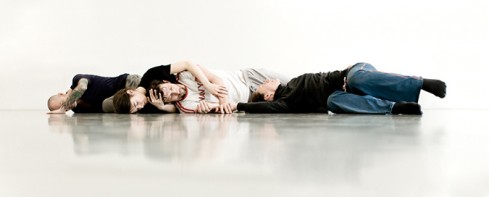The paradox behind the Tabernacle
Choreographer Fearghus Ó Conchúir premieres his latest project tonight at the Dublin Dance Festival – but despite being about the Catholic Church and the Irish body, he’s not preaching,he tells MICHAEL SEAVER
SOME ADVANCE publicity for Tabernacle has a bit too much emphasis on the issue of clerical abuse for choreographer Fearghus Ó Conchúir’s taste. The dance performance, which premieres tonight as part of the Dublin Dance Festival, is about “the Catholic Church and the making of the Irish body”.
“It would be naive to think that you could make a work about the Catholic Church in Ireland without referring to [clerical abuse],” he says. “But I’m aware that there might be expectations that I’ll be taking on the institution on behalf of the victims.”
That’s not Ó Conchúir’s style. His recent project, Bodies and Buildings, focused on how the changing architecture in Dublin’s Docklands has transformed the relationship between individuals and the built environment. It wasn’t a broadside at what we lost during the boom times. Instead, he encouraged re-evaluation by simply placing his dancing body within the evolving architecture and allowing that juxtaposition to remind viewers of the human stories that were being destroyed by construction.
When Ó Conchúir was invited to perform in China in 2007, he chose the site of the Olympic stadium in Beijing to reconnect in the same way with the communities that had been destroyed to make room for the new structure.
Calmly conceived and intellectually robust, the strategy doesn’t just produce eloquent movement, it creates powerful art.
In Mo Mhórchoir Féin – A Prayer , a short film broadcast during last year’s Dublin Dance Festival as part of the RTÉ Dance on the Box series, his tall, athletic body danced in front of an altar while dressed only in white underwear. His movements highlighted the uncomfortable relationship between the Catholic Church and the body.
“If I was to specifically address the issue of abuse in the Catholic Church in my work, I would set up an opposition that would keep me in direct contact with the very thing I was opposing,” he says. “I suppose I’m not a very confrontational person and I find that confrontation just creates a black-and-white, a them-and-us [perspective] that stays stuck together.”
Instead he will allow the darkness of the abuses to infiltrate the work, so they are a simmering undertone rather than an obvious focus.
Ó Conchúir doesn’t want to preach. “I’d rather let the dancers embody something that allows people to think rather than just passively receive,” he says.
At one point in Tabernacle , dancer Bernadette Iglich is held aloft with her midriff exposed. One by one the other dancers kiss the side of her stomach, gently at first, then becoming quicker and more frenetic. The image is venerational, sensual, respectful and yet abusive. This is the kind of ambiguity that he tries to advocate. He has taken his inspiration from religious iconography.
“In some cultures, there is an emphasis on the pain of the crucified Christ. In others, sensuality is emphasised or sometimes the two mixed together,” he explains. “I want the audience to experience a similar complexity and complicated relationship with the images the dancers present on stage.”
Although many choreographers are seen as authority figures, Ó Conchúir does not want to be seen that way. “There is a danger that commitment to an authority system can lead to protecting that system, like what happened in the Catholic church,” he says. “Certain choreographers dictate moves to the dancers and control their bodies. I’m finding ways of working that don’t replicate that power.”
This means creating a democratic environment in which opinions are valued and shared. Throughout the rehearsal process, he invites people to watch sections of the dance and to offer feedback. These range from the dancers to fellow choreographers to members of the Machushla Dance Club, a dance group for those over 50 years old.
He uses the feedback to make his images more ambiguous rather than more evident, however. When somebody suggested that a movement reminded them of Jesus carrying the cross, Ó Conchúir encouraged the dancer to put that image out of her mind so the movement didn’t simply become a depiction of Jesus’s actions.
Although he avoids dictatorial choreography with its emphasis on precision and timing, he acknowledges the parallels between it and the rituals he went through as an altar boy, kneeling down or ringing a bell at the correct moment. “My body got its physical training on the sports field, but its aesthetic training in church,” he says.
Tabernacle is at Project Arts Centre today and tomorrow as part of the Dublin Dance Festival. See dublindancefestival.ie
This article appears in the print edition of the Irish Times. Friday, May 27, 2011

